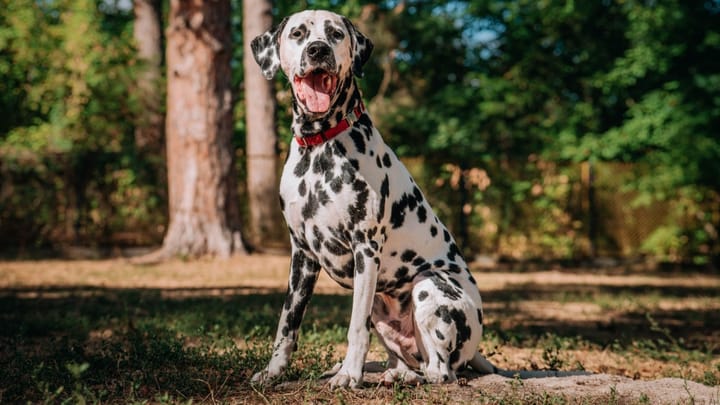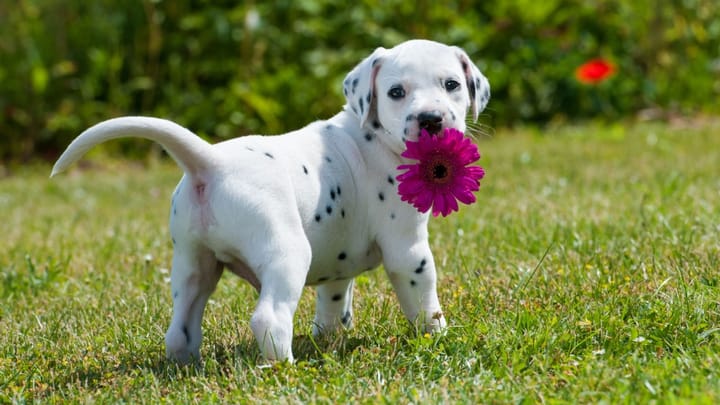Dalmatian
Other names : Dalmatinski pas, Carriage Dog, Spotted Coach Dog, Leopard Carriage Dog, Firehouse Dog, Plum Pudding Dog


The Dalmatian is certainly one of the most recognisable breed of its species. He is difficult to mistake for another breed, on account of his very unique appearance. But his majestic demeanour should not be the only criterium to take into account when choosing to adopt this spotted dog. In reality, he does not have an easy character and is only suitable for experienced dog owners, ready to invest time and energy in his rearing, and in meeting his ample needs for exercise.
|
Life expectancy |
The Dalmatian has a life expectancy of between 10 and 12 years |
|
Temperament |
|
|
Size |
Medium
|
|
Adult size |
Female
Between 21 and 24 in
Male
Between 22 and 24 in
|
|
Adult weight |
Female
Between 53 and 71 lb
Male
Between 53 and 71 lb
|
|
Coat colour
The base is a pure white, covered in black or liver-coloured flecks. The flecks must be small, round, clearly delineated and without smudging, roughly the size of a coin. Do note that brown (liver) Dalmatians exist, but are all in all quite rare. |
White Black Brown |
|
Type of coat
The coat is short. The hair is coarse, dense, smooth and shiny. |
Short Hard |
|
Eye colour
The eyes are dark in individuals with black spots, while they are amber-coloured in the rare, liver-spotted variety. |
Brown
Odd-eyed
|
|
Purchase price |
The Dalmatian costs between £560 and £710 |
He has become known in popular culture through the ‘101 Dalmatians’ film, but this popularity has led to rendering the breed fragile, since it resulted in an overproduction of pups that were not necessarily of best possible quality. You must be careful to adopt only from specialised, reputable breeders.
More details about the Dalmatian
Dalmatian: Origins and history
His origins remain a source of controversy, and several countries claim to be his birthplace, yet the FCI has determined the breed’s roots as Croatian, even if certain experts believe it to be oriental, while others English. England is, at any rate, one of its adoptive homelands. Presumably bred for the purpose of hunting, a theory backed by his Pointer dog aspect, he was quick to become a ‘coach dog’, before eventually ‘graduating’ onto companion dog- he never will be a ‘toy dog’ though. The Dalmatian is actually a remarkably good hunting dog, contrary to popular belief. The first official standards for the breed were established in 1890, right around the same time as the creation of the English Dalmatian Club. The FCI then published the standards in 1955.
Physical characteristics of the Dalmatian
The Dalmatian generally appears as an active, well and symmetrically-built dog, without ever seeming stocky or heavy. The muzzle is long, lean and never pointy. The stop is slightly pronounced, while the eyes are medium-sized, round, animated and intelligent-looking. The ears are set high, moderately-sized and folded over sides of the head- they are always heavily flecked. Solid black ears (such as Pongo’s in ‘101 Dalmatians’) are considered a defect. The tail reaches the hock and curves slightly upwards, but is never completely curled over.
FCI classification of the Dalmatian
-
Group 6 - Scent hounds and related breeds
-
Section 3 : Related breeds
Dalmatian: Characteristics
Dalmatian: Behaviour
Training a Dalmatian
Usually perceived as quite an independent animal, the Dalmatian is in fact very stubborn, especially if his owner does not understand him and does not treat him as an equal, which is the only treatment this proud dog will accept. Any show of brutality towards this Croatian dog will be destined to failure and will only serve to sully the master-dog relationship.
The Dalmatian is considered the professional dog trainer’s ‘achilles’ heel’. He is, indeed, difficult to train. It is important to set some boundaries for him from a young age and to maintain a coherent exchange with him, without which communication will be rendered impossible.
Novice or overly lax owners will quickly become overwhelmed by this strong-tempered dog. A strict yet respectful handling, consisting of positive-reinforcement methods, will be crucial.
It is only with a healthy dose of patience, determination and perseverance that the Dalmatian’s owners will obtain satisfactory results.
Dalmatian: Lifestyle
Breed compatibility Dalmatian
Dalmatian: Purchase price
The price of a Dalmatian varies depending on its origins, age, and sex. You have to count an average of £710 for dogs registered at the Kennel Club.
With regards to the monthly budget required to meet the needs of a dog of this size, you have to estimate an average of £40 per month.
Dalmatian: Shedding
Average
Hair loss is, all in all, quite moderate, but becomes more pronounced during the two yearly moulting seasons: autumn and spring. The brushes will then have to go from weekly to daily, in order to remove as many residual dead hairs as possible.
Dalmatian: Grooming
This Croatian dog’s short and smooth coat does not require much strenuous care and even less bathing.
However, brushes will need to be carried at least once a week to preserve the cleanliness and protective qualities of his coat.
Dalmatian: Health
Life expectancy is 11 years on average.
Generally resilient, the Dalmatian is an active and rather robust dog.
You must always be aware of the risk of sun strokes in the case of short-coated breeds whose dominant colour is white. During the summer, you must opt for walks early in the morning and late in the evening, caring never to expose the dog to the sun for too long.
It is advised that you have the Dalmatian sleep indoors, since his short and smooth coat does not equip him with much resistance to cold.
Quite the eater, the Dalmatian is also luckily very high-performance, which helps him in quickly disposing of excess calories. However, be wary of less active individuals- insufficient exercise will rapidly lead to weight gain.
- Issues with deafness, typical of Dalmatians yet still very rare thanks to breeders’ efforts
- Urinary stones and kidney diseases (hereditary nephropathy) cause by an elevated level of uric acid
- Hip Dysplasia
- Esophageal achalasia







